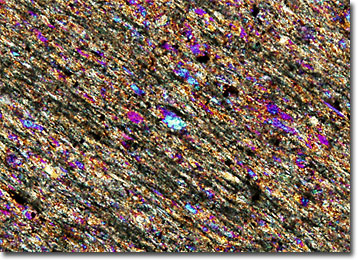Polarized Light Microscopy Digital Image Gallery
Green Slate
Slates are metamorphic rocks, most of which were formed millions of years ago and began as clay sediments deposited by water. Widely utilized, slate is mined in a number of locations, including the Rocky Mountains, Maine, Vermont, and Pennsylvania in the United States.

Slates exhibit perfect cleavage into thin, broad layers of rock due to the orientation of the flaky minerals they contain. Thus, these economically important rocks are readily quarried into smooth surfaced sheets of material that can be used for a variety of applications. Some of the earliest uses of slate include tombstones, tiling, and writing tablets, appropriately known as “slates.” Among the items that slate has more recently been used to make are blackboards, sinks, mantels, and pool tabletops. Crushed slate also gains use in aggregates and fillers.
The mineral composition of slates is quite various, which results in a wide range of colors that may occur in the rock. Green slates are usually formed when there is significant quantity of chlorite, a dark green clay mineral, present. Red and purple varieties, however, typically owe their hues to the presence of hematite, and carbonaceous material is often the source of the color in dark gray or black slates.
